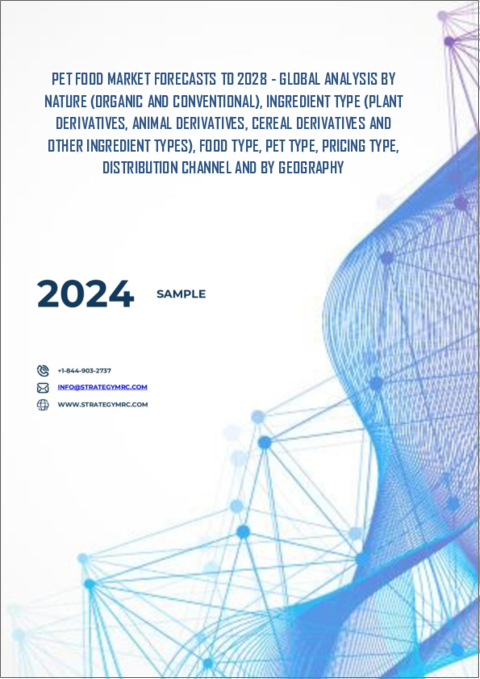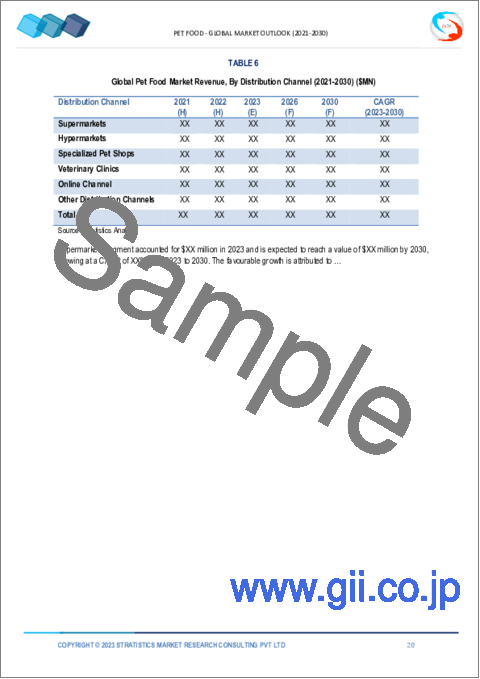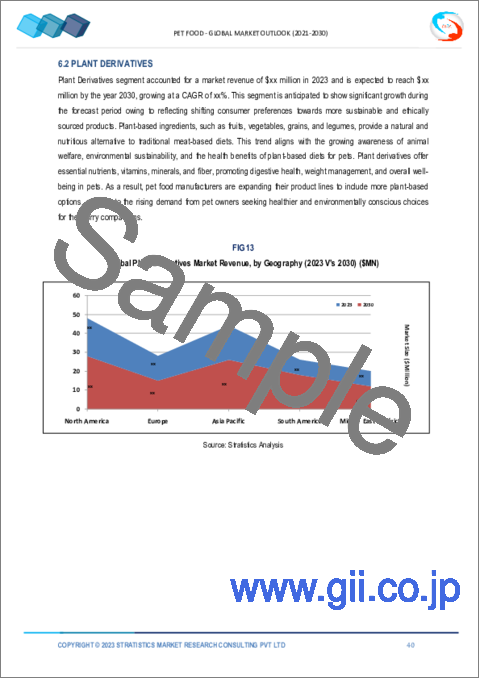|
|
市場調査レポート
商品コード
1284056
ペットフード市場の2028年までの予測- 性質別、原材料の種類別、食品タイプ別、ペットの種類別、価格タイプ別、流通チャネル別、地域別の世界分析Pet Food Market Forecasts to 2028 - Global Analysis By Nature, Ingredient Type, Food Type, Pet Type, Pricing Type, Distribution Channel and By Geography |
||||||
カスタマイズ可能
|
|||||||
| ペットフード市場の2028年までの予測- 性質別、原材料の種類別、食品タイプ別、ペットの種類別、価格タイプ別、流通チャネル別、地域別の世界分析 |
|
出版日: 2023年06月01日
発行: Stratistics Market Research Consulting
ページ情報: 英文 175+ Pages
納期: 2~3営業日
|
- 全表示
- 概要
- 図表
- 目次
Stratistics MRCによると、ペットフードの世界市場は2022年に518億9,000万米ドルを占め、2028年にはCAGR4.6%の成長で679億7,000万米ドルに達すると予想されています。
ペットフードは、ペットが食べることを目的とした動物用飼料です。特に犬や同種のイヌのために作られたものです。ペットフードは、感染症や皮膚アレルギーの予防に役立つと同時に、動物の一般的な健康状態や寿命も向上させます。ペットフードは、ペットの消化器官が必要な栄養素に簡単にアクセスできるように設計されており、体に吸収されやすくなっています。ペットフードは、健康な免疫システムをサポートし、つややかな毛並みを保ち、ペットの活動的なライフスタイルを促進する栄養バランスのとれた食材を提供しています。
米国ペット用品協会(APPA)の「全米ペット飼育者調査2019-20」によると、米国では6,340万世帯がペットとして犬を飼育しており、これは同国の全ペット飼育世帯の約74.6%にあたります。
市場力学:
促進要因
ペットのヒューマニゼーションの傾向の高まり
近年、主要メディアはペットのヒューマニゼーションに大きな関心を寄せています。特に富裕層では、ペットの所有から子育てへの移行が、ペットフード業界において重要かつ決定的な進展となっています。ペットは家族の一員とみなされるようになったのです。消費者のペットフードへの購買意欲は、ペットオーナーと動物との間の愛着の深まりによって左右されます。ペットを「人間化」する傾向は、健康への意識を高め、ペットフードの需要を促進しました。
抑制要因
厳しい規制
ペットフードは、特に欧米市場では、最も厳しい規制がある食品のひとつです。新興国市場では、ペットフードに使用される原材料から販売、マーケティングに至るまで、あらゆるレベルで厳しい検査が行われています。商品化に必要な高い基準は、市場拡大の大きな障壁となる可能性があります。
機会
オーガニック製品への需要の高まり
オーガニックフードを食べているペットは、皮膚や被毛の状態が良く、活力があり、体重も健康的である可能性があります。与えられた餌を消化しやすくなります。オーガニック製品に対する需要の高まりを受けて、より幅広いフレーバーの商品が提供され、プロバイオティクスや抗酸化物質などの必要な要素が加えられています。オーガニックペットフードの需要は、ペットの健康に対する理解の向上によっても促進されています。
脅威
高価格帯
ペットフードの主な原材料は、穀物、果物、動物性タンパク質から作られる食事です。これらの原材料は、価格や規格、入手方法が頻繁に変化しています。そのため、住民の方々はペットを手放すことを検討されています。ペットフードのこのような突然の大幅な価格上昇は、市場の拡大に悪影響を及ぼすかもしれません。さらに、顧客からの問い合わせの増加や輸出市場の見積もり上昇も、市場に影響を与えています。
COVID-19の影響:
COVID-19の流行により、食材や原材料の入手が損なわれ、世界中のサプライチェーンが寸断されました。物流への影響と景気後退により、製品需要は大幅に減少しています。封鎖中は、ペットオーナーもペットフードを買いだめしたため、一時的に売上が伸びた。しかし、ロックダウンの緩和により、オペレーションは通常通りに戻りました。
予測期間中、ドライフード分野が最大になると予想される
ドライフード分野は、その利便性と手頃な価格から、有利な成長を遂げると推定されます。ドライフードは、ペットの歯の健康を維持するのに役立ちます。ドライフードは保存期間が長く、特別な保管設備や冷蔵を必要としないです。一定の食生活を維持するために、フードを素早く計量し、正しく分量することができます。より安価な価格帯で購入でき、十分に脱水することで細菌、酵母、カビの繁殖を防ぐことができます。
予測期間中、犬用が最も高いCAGRを示すと予想されます。
犬分野は、予測期間中に最も速いCAGRの成長が見込まれます。犬は最も人気のある家庭用ペットです。彼らの食事は主に肉で構成されています。このため、犬用おやつや栄養価の高い食事がイントロダクションとして提供されています。その結果、ペットフードメーカーがさまざまなドッグフードを開発することで、有利な可能性があります。自然で高品質なドッグフードの市場は、イヌの維持とケアにかかる高いコストによって牽引されています。
最もシェアの大きい地域
北米は、消費者の意識の高まりとペットの人間化の傾向から、予測期間中に最大の市場シェアを占めると予測されます。同地域では、全世帯の約67%がペットを飼っています。北米では、ペットのヒューマニゼーションが受け入れられ、世間からの評価も高いことから、ペットフード製品の市場拡大が期待されています。
CAGRが最も高い地域:
予測期間中、南米が最も高いCAGRを示すと予測されています。ブラジルはペットフード製品の世界第2位の市場であり、最も多様なペット人口を有しています。ブラジルは、ペットの飼育率の高さ、ペットの健康への関心の高まり、天然素材の高級ペットフードへの支出の増加により、南米市場で圧倒的な地位を占めています。また、小家族や子供のいない夫婦、アパート住まいの人などに鳥や魚がペットとして好まれ、市場の拡大に拍車をかけています。
主な発展:
2021年7月、Nestle Purina PetCare Co.は、米国バージニア州キングウィリアム郡のペットケア製品の製造施設を拡張するために1億8,200万米ドルを投資しました。2023年後半までに完了予定の工場拡張では、138,000平方フィートの増築を行い、同社の砂製品ライン「Tidy Cat」の製造能力を向上させる予定です。
2021年6月、Mars Inc.はWhiskasブランドでウェットキャットフードを発売し、インドでの製品レンジを拡大しました。新しい製品群は、ペットショップ、食料品店、eコマースサイトで販売されています。
2021年6月、Colgate-Palmolive Companyは米国に25,000平方フィートの栄養イノベーションセンターを開設しました。このセンターでは、小型犬やミニドッグ向けに特別に設計された革新的な製品を開発することが可能になります。
当レポートが提供するもの
- 地域別、国別セグメントの市場シェア評価
- 新規参入企業への戦略的提言
- 2020年、2021年、2022年、2025年、2028年の市場データを網羅
- 市場促進要因(市場動向、制約要因、機会、脅威、課題、投資機会、推奨事項)。
- 市場推定に基づく、主要ビジネスセグメントにおける戦略的提言
- 主要な共通トレンドをマッピングした競合情勢。
- 詳細な戦略、財務、最近の開発状況を含む企業プロファイル
- 最新の技術的進歩をマッピングしたサプライチェーン動向
無料のカスタマイズ提供:
本レポートをご購入いただいたお客様には、以下の無料カスタマイズオプションのいずれかを提供させていただきます:
- 企業プロファイル
- 追加市場プレイヤーの包括的なプロファイリング(最大3社まで)
- 主要プレイヤーのSWOT分析(3社まで)
- 地域別セグメンテーション
- お客様のご希望に応じて、主要国の市場推計・予測・CAGR(注:フィージビリティチェックによる。)
- 競合ベンチマーキング
- 製品ポートフォリオ、地域的プレゼンス、戦略的提携に基づく主要プレイヤーのベンチマーキング
目次
第1章 エグゼクティブサマリー
第2章 序文
- 概要
- ステークホルダー
- 調査範囲
- 調査手法
- データマイニング
- データ分析
- データ検証
- 調査アプローチ
- 調査ソース
- 1次調査ソース
- 2次調査ソース
- 仮定
第3章 市場動向分析
- 促進要因
- 抑制要因
- 機会
- 脅威
- 新興市場
- 新型コロナウイルス感染症(COVID-19)の影響
第4章 ポーターのファイブフォース分析
- 供給企業の交渉力
- 買い手の交渉力
- 代替品の脅威
- 新規参入業者の脅威
- 競争企業間の敵対関係
第5章 世界のペットフード市場:性質別
- オーガニック
- 従来型
第6章 世界のペットフード市場:原材料の種類別
- 植物誘導体
- 動物由来物
- 穀物誘導体
- その他の成分の種類
第7章 世界のペットフード市場:食品タイプ別
- ウェットフード
- 乾燥食品
- おやつ/スナック
- 獣医用食事療法
- 冷凍品
- 生物
- 他の食品の種類
第8章 世界のペットフード市場:ペットの種類別
- 猫
- 犬
- 鳥
- ウサギ
- ハムスター
- その他のペットの種類
第9章 世界のペットフード市場:価格タイプ別
- 通常商品
- 大量生産品
- プレミアム製品
第10章 世界のペットフード市場:流通チャネル別
- スーパーマーケット
- ハイパーマーケット
- ペット専門店
- 動物病院
- オンラインチャンネル
- その他の流通チャネル
第11章 世界のペットフード市場:地域別
- 北米
- 米国
- カナダ
- メキシコ
- 欧州
- ドイツ
- 英国
- イタリア
- フランス
- スペイン
- その他欧州
- アジア太平洋地域
- 日本
- 中国
- インド
- オーストラリア
- ニュージーランド
- 韓国
- その他アジア太平洋地域
- 南米
- アルゼンチン
- ブラジル
- チリ
- その他南米
- 中東とアフリカ
- サウジアラビア
- アラブ首長国連邦
- カタール
- 南アフリカ
- その他中東とアフリカ
第12章 主な発展
- 契約、パートナーシップ、コラボレーション、合弁事業
- 買収と合併
- 新製品の発売
- 事業拡大
- その他の主要戦略
第13章 会社概要
- Nestle Purina Petcare Company
- The J.M. Smucker Company
- Colgate-Palmolive Company
- Schell & Kampeter, Inc
- Mars Inc
- Evanger's Dog & Cat Food Company, Inc
- Champion Petfoods
- Nutro Products Inc
- Betagro Public Company Limited
- WellPet Inc
- 4Legs Pet Food Company
- Heristo AG
- Lafeber Co.
- Fromm Family Foods LLC.
- Dave's Pet Food
- Boulder Dog Food Company L.L.C.
- Farmina Pet Foods
- Blue Buffalo Ltd
List of Tables
- Table 1 Global Pet Food Market Outlook, By Region (2020-2028) ($MN)
- Table 2 Global Pet Food Market Outlook, By Nature (2020-2028) ($MN)
- Table 3 Global Pet Food Market Outlook, By Organic (2020-2028) ($MN)
- Table 4 Global Pet Food Market Outlook, By Conventional (2020-2028) ($MN)
- Table 5 Global Pet Food Market Outlook, By Ingredient Type (2020-2028) ($MN)
- Table 6 Global Pet Food Market Outlook, By Plant Derivatives (2020-2028) ($MN)
- Table 7 Global Pet Food Market Outlook, By Animal Derivatives (2020-2028) ($MN)
- Table 8 Global Pet Food Market Outlook, By Cereal Derivatives (2020-2028) ($MN)
- Table 9 Global Pet Food Market Outlook, By Other Ingredient Types (2020-2028) ($MN)
- Table 10 Global Pet Food Market Outlook, By Food Type (2020-2028) ($MN)
- Table 11 Global Pet Food Market Outlook, By Wet Food (2020-2028) ($MN)
- Table 12 Global Pet Food Market Outlook, By Dry Food (2020-2028) ($MN)
- Table 13 Global Pet Food Market Outlook, By Treats/Snacks (2020-2028) ($MN)
- Table 14 Global Pet Food Market Outlook, By Veterinary Diets (2020-2028) ($MN)
- Table 16 Global Pet Food Market Outlook, By Frozen Products (2020-2028) ($MN)
- Table 17 Global Pet Food Market Outlook, By Raw Food (2020-2028) ($MN)
- Table 18 Global Pet Food Market Outlook, By Other Food Types (2020-2028) ($MN)
- Table 19 Global Pet Food Market Outlook, By Pet Type (2020-2028) ($MN)
- Table 20 Global Pet Food Market Outlook, By Cats (2020-2028) ($MN)
- Table 21 Global Pet Food Market Outlook, By Dogs (2020-2028) ($MN)
- Table 22 Global Pet Food Market Outlook, By Birds (2020-2028) ($MN)
- Table 23 Global Pet Food Market Outlook, By Rabbits (2020-2028) ($MN)
- Table 24 Global Pet Food Market Outlook, By Hamsters (2020-2028) ($MN)
- Table 25 Global Pet Food Market Outlook, By Other Pet Types (2020-2028) ($MN)
- Table 26 Global Pet Food Market Outlook, By Pricing Type (2020-2028) ($MN)
- Table 27 Global Pet Food Market Outlook, By Normal Products (2020-2028) ($MN)
- Table 28 Global Pet Food Market Outlook, By Mass Products (2020-2028) ($MN)
- Table 29 Global Pet Food Market Outlook, By Premium Products (2020-2028) ($MN)
- Table 30 Global Pet Food Market Outlook, By Distribution Channel (2020-2028) ($MN)
- Table 31 Global Pet Food Market Outlook, By Supermarkets (2020-2028) ($MN)
- Table 32 Global Pet Food Market Outlook, By Hypermarkets (2020-2028) ($MN)
- Table 33 Global Pet Food Market Outlook, By Specialized Pet Shops (2020-2028) ($MN)
- Table 34 Global Pet Food Market Outlook, By Veterinary Clinics (2020-2028) ($MN)
- Table 35 Global Pet Food Market Outlook, By Online Channel (2020-2028) ($MN)
- Table 36 Global Pet Food Market Outlook, By Other Distribution Channels (2020-2028) ($MN)
Note: Tables for North America, Europe, APAC, South America, and Middle East & Africa Regions are also represented in the same manner as above.
According to Stratistics MRC, the Global Pet Food Market is accounted for $51.89 billion in 2022 and is expected to reach $67.97 billion by 2028 growing at a CAGR of 4.6% during the forecast period. Pet food is animal feed intended for consumption by pets. They have been created especially for dogs and other canines of a similar species. Pet food aids in preventing infections and skin allergies while also enhancing the general wellbeing and lifespan of animals. They are designed in such a way that pet's digestive system can simply access the necessary nutrients, which makes it simple for the body to absorb them. Pet food provides nutritionally balanced ingredients that support a healthy immune system, maintain a glossy coat, and promote a more active lifestyle in pets.
According to the American Pet Products Association's (APPA) National Pet Owners Survey 2019-20, 63.4 million households in US own dogs as pets, which is about 74.6% of the country's total pet-owning households.
Market Dynamics:
Driver:
Rising trend of pet humanization
In recent times, the mainstream media has given a lot of attention to the humanization of pets. Particularly in affluent nations, the transition from pet ownership to pet parenting has been a significant and defining development in the pet food industry. Pets are seen as members of the family. Consumer's willingness to spend more on pet food is influenced by the deepening attachment between pet owners and their animals. The tendency of "humanizing" pets has raised health awareness and propelled the demand for pet food.
Restraint:
Strict regulations
Pet food tends to be one of the food items with the strictest regulations, particularly in western markets. Pet animal meals are rigorously inspected in developed markets at every level, from the ingredients used in food preparation through sales and marketing. The high standards required for commercialization may be a significant barrier to the market's expansion.
Opportunity:
Growing demand for organic products
Pets that eat organic food may have better-looking skin and coats, more vitality, and a healthier weight. They have an easier time digesting the food they are given. The availability of goods in a wider range of flavours and the addition of necessary elements like probiotics and antioxidants has expanded in response to the growing demand for organic products. The demand for organic pet food is also fuelled by a better understanding of pet health.
Threat:
High price range
The primary ingredients used in each pet food product are grains, fruits and meals made from animal protein. These essential element's prices, standards and availability have been changing often. Because of this, the residents are considering giving away their pets. Such an abrupt and significant price hike on pet food might have a negative impact on market expansion. Additionally, the market is also being impacted by an increase in customer inquiries and rising exporting market quotations.
COVID-19 Impact:
The COVID-19 epidemic has damaged the availability of ingredients and raw materials and has thrown off supply chains all across the world. Impacted logistics and the economic downturn have significantly reduced product demand. During the lockdown, pet owners stocked up on pet food as well, which temporarily boosted sales. However, the operations were back to normal due to the ease of the lockdown.
The dry food segment is expected to be the largest during the forecast period
The dry food segment is estimated to have a lucrative growth, due to its convenience and affordability. Dry food aids in keeping pet's dental systems healthy. It has a longer shelf life and doesn't need special storage facilities or refrigeration. To maintain a constant diet, food may be measured out quickly and portioned correctly. It benefits at a much cheaper price range and sufficiently dehydrates the food to prevent the growth of germs, yeast, and molds.
The dogs segment is expected to have the highest CAGR during the forecast period
The dogs segment is anticipated to witness the fastest CAGR growth during the forecast period. Dogs are the most popular household pet. Their diets consist primarily of meat. This factor prompts the introduction of dog treats and nutrient-dense meals. As a result, there is a lucrative potential for pet food producers to develop a variety of dog food items. The market for natural and higher-quality dog food is being driven by the high cost of maintaining and caring for canines.
Region with largest share:
North America is projected to hold the largest market share during the forecast period owing to the rising consumer awareness and trend of pet humanization. Approximately 67% of the total households present in this region have pets. The acceptance of pet humanization and the favourable public perception of it in North America are fostering market expansion for wholesome pet food products.
Region with highest CAGR:
South America is projected to have the highest CAGR over the forecast period. Brazil is the second-largest market in the world for pet food products and has most varied pet population. Brazil holds a dominant position in the South American market due to high rates of pet ownership, an increasing emphasis on pet health, and rising expenditures on natural, premium pet foods. Birds and fish are preferred as pets by small families, childless couples, and individuals living in flats, which is fuelling the market's expansion.
Key players in the market:
Some of the key players profiled in the Pet Food Market include Nestle Purina Petcare Company, The J.M. Smucker Company, Colgate-Palmolive Company, Schell & Kampeter, Inc, Mars Inc, Evanger's Dog & Cat Food Company, Inc, Champion Petfoods, Nutro Products Inc, Betagro Public Company Limited, WellPet Inc, 4Legs Pet Food Company, Heristo AG, Lafeber Co., Fromm Family Foods LLC., Dave's Pet Food, Boulder Dog Food Company L.L.C., Farmina Pet Foods and Blue Buffalo Ltd.
Key Developments:
In July 2021, Nestle Purina PetCare Co. invested USD 182 million to expand its pet care products' manufacturing facility in King William County, Virginia, US. The factory expansion, which is scheduled to be completed by late 2023, will include a 138,000 square foot build out to increase manufacturing capacity for the company's Tidy Cat litter products line.
In June 2021, Mars Inc. launched wet cat food under its Whiskas brand, expanding its product range in India. The new product range is available across pet shops, grocery stores, and e-commerce sites.
In June 2021, Colgate-Palmolive Company opened a 25,000 square foot nutrition innovation center in the US. This center would enable the company to develop innovative products specially designed for small and mini dogs.
Natures Covered:
- Organic
- Conventional
Ingredient Types Covered:
- Plant Derivatives
- Animal Derivatives
- Cereal Derivatives
- Other Ingredient Types
Food Types Covered:
- Wet Food
- Dry Food
- Treats/Snacks
- Veterinary Diets
- Frozen Products
- Raw Food
- Other Food Types
Pet Types Covered:
- Cats
- Dogs
- Birds
- Rabbits
- Hamsters
- Other Pet Types
Pricing Types Covered:
- Normal Products
- Mass Products
- Premium Products
Distribution Channels Covered:
- Supermarkets
- Hypermarkets
- Specialized Pet Shops
- Veterinary Clinics
- Online Channel
- Other Distribution Channels
Regions Covered:
- North America
- US
- Canada
- Mexico
- Europe
- Germany
- UK
- Italy
- France
- Spain
- Rest of Europe
- Asia Pacific
- Japan
- China
- India
- Australia
- New Zealand
- South Korea
- Rest of Asia Pacific
- South America
- Argentina
- Brazil
- Chile
- Rest of South America
- Middle East & Africa
- Saudi Arabia
- UAE
- Qatar
- South Africa
- Rest of Middle East & Africa
What our report offers:
- Market share assessments for the regional and country-level segments
- Strategic recommendations for the new entrants
- Covers Market data for the years 2020, 2021, 2022, 2025, and 2028
- Market Trends (Drivers, Constraints, Opportunities, Threats, Challenges, Investment Opportunities, and recommendations)
- Strategic recommendations in key business segments based on the market estimations
- Competitive landscaping mapping the key common trends
- Company profiling with detailed strategies, financials, and recent developments
- Supply chain trends mapping the latest technological advancements
Free Customization Offerings:
All the customers of this report will be entitled to receive one of the following free customization options:
- Company Profiling
- Comprehensive profiling of additional market players (up to 3)
- SWOT Analysis of key players (up to 3)
- Regional Segmentation
- Market estimations, Forecasts and CAGR of any prominent country as per the client's interest (Note: Depends on feasibility check)
- Competitive Benchmarking
- Benchmarking of key players based on product portfolio, geographical presence, and strategic alliances
Table of Contents
1 Executive Summary
2 Preface
- 2.1 Abstract
- 2.2 Stake Holders
- 2.3 Research Scope
- 2.4 Research Methodology
- 2.4.1 Data Mining
- 2.4.2 Data Analysis
- 2.4.3 Data Validation
- 2.4.4 Research Approach
- 2.5 Research Sources
- 2.5.1 Primary Research Sources
- 2.5.2 Secondary Research Sources
- 2.5.3 Assumptions
3 Market Trend Analysis
- 3.1 Introduction
- 3.2 Drivers
- 3.3 Restraints
- 3.4 Opportunities
- 3.5 Threats
- 3.6 Emerging Markets
- 3.7 Impact of Covid-19
4 Porters Five Force Analysis
- 4.1 Bargaining power of suppliers
- 4.2 Bargaining power of buyers
- 4.3 Threat of substitutes
- 4.4 Threat of new entrants
- 4.5 Competitive rivalry
5 Global Pet Food Market, By Nature
- 5.1 Introduction
- 5.2 Organic
- 5.3 Conventional
6 Global Pet Food Market, By Ingredient Type
- 6.1 Introduction
- 6.2 Plant Derivatives
- 6.3 Animal Derivatives
- 6.4 Cereal Derivatives
- 6.5 Other Ingredient Types
7 Global Pet Food Market, By Food Type
- 7.1 Introduction
- 7.2 Wet Food
- 7.3 Dry Food
- 7.4 Treats/Snacks
- 7.5 Veterinary Diets
- 7.6 Frozen Products
- 7.7 Raw Food
- 7.8 Other Food Types
8 Global Pet Food Market, By Pet Type
- 8.1 Introduction
- 8.2 Cats
- 8.3 Dogs
- 8.4 Birds
- 8.5 Rabbits
- 8.6 Hamsters
- 8.7 Other Pet Types
9 Global Pet Food Market, By Pricing Type
- 9.1 Introduction
- 9.2 Normal Products
- 9.3 Mass Products
- 9.4 Premium Products
10 Global Pet Food Market, By Distribution Channel
- 10.1 Introduction
- 10.2 Supermarkets
- 10.3 Hypermarkets
- 10.4 Specialized Pet Shops
- 10.5 Veterinary Clinics
- 10.6 Online Channel
- 10.7 Other Distribution Channels
11 Global Pet Food Market, By Geography
- 11.1 Introduction
- 11.2 North America
- 11.2.1 US
- 11.2.2 Canada
- 11.2.3 Mexico
- 11.3 Europe
- 11.3.1 Germany
- 11.3.2 UK
- 11.3.3 Italy
- 11.3.4 France
- 11.3.5 Spain
- 11.3.6 Rest of Europe
- 11.4 Asia Pacific
- 11.4.1 Japan
- 11.4.2 China
- 11.4.3 India
- 11.4.4 Australia
- 11.4.5 New Zealand
- 11.4.6 South Korea
- 11.4.7 Rest of Asia Pacific
- 11.5 South America
- 11.5.1 Argentina
- 11.5.2 Brazil
- 11.5.3 Chile
- 11.5.4 Rest of South America
- 11.6 Middle East & Africa
- 11.6.1 Saudi Arabia
- 11.6.2 UAE
- 11.6.3 Qatar
- 11.6.4 South Africa
- 11.6.5 Rest of Middle East & Africa
12 Key Developments
- 12.1 Agreements, Partnerships, Collaborations and Joint Ventures
- 12.2 Acquisitions & Mergers
- 12.3 New Product Launch
- 12.4 Expansions
- 12.5 Other Key Strategies
13 Company Profiling
- 13.1 Nestle Purina Petcare Company
- 13.2 The J.M. Smucker Company
- 13.3 Colgate-Palmolive Company
- 13.4 Schell & Kampeter, Inc
- 13.5 Mars Inc
- 13.6 Evanger's Dog & Cat Food Company, Inc
- 13.7 Champion Petfoods
- 13.8 Nutro Products Inc
- 13.9 Betagro Public Company Limited
- 13.10 WellPet Inc
- 13.11 4Legs Pet Food Company
- 13.12 Heristo AG
- 13.13 Lafeber Co.
- 13.14 Fromm Family Foods LLC.
- 13.15 Dave's Pet Food
- 13.16 Boulder Dog Food Company L.L.C.
- 13.17 Farmina Pet Foods
- 13.18 Blue Buffalo Ltd





